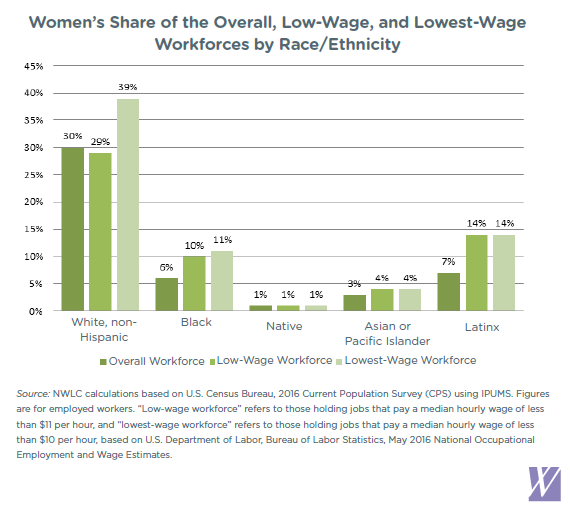
 By Jasmine Tucker and Kayla Patrick
By Jasmine Tucker and Kayla Patrick
Over the last several decades, women have gained ever increasing levels of work experience and educational attainment—but despite this sharp increase in credentials, women are still far more likely than men to work for low pay. Although women make up just under half of the overall workforce, they make up nearly six in ten workers in the low-wage workforce (i.e., in jobs that typically pay less than $11 per hour). And the lower paid the job, the greater women’s overrepresentation: women make up close to seven in ten workers in jobs that typically pay less than $10 per hour.
No matter how you slice the numbers, a stark reality persists: regardless of their education level, parental status, race or ethnicity, regardless of whether they are foreign born or native born, women generally make up larger shares of the low-wage workforce than do their male counterparts. Most demographic groups of women are overrepresented in the low-wage workforce compared to their representation in the workforce overall.
Women are overrepresented in the low-wage workforce.
- Despite making up less than half (47 percent) of all workers, women are nearly six in ten (58 percent) of the more than 26 million workers in low-wage occupations that typically pay less than $11 per hour.
- Women are nearly seven in ten (69 percent) of the close to 7 million workers in the lowest-wage occupations that typically pay less than $10 per hour.

Regardless of race or ethnicity, women make up larger shares of the low-wage workforce than their male counterparts.
- Across racial and ethnic groups, women account for larger shares of the low-wage and lowest-wage workforce than their male counterparts, even though their shares of the overall workforce are similar or smaller.
- Women of virtually all races and ethnicities are overrepresented in jobs that typically pay less than $11 per hour and in those that typically pay less than $10 per hour, compared to their representation in the workforce as a whole. And while white, non-Hispanic women are proportionately represented in the low-wage workforce, they are overrepresented in the lowest-wage workforce.
- Meanwhile, white, non-Hispanic men are dramatically underrepresented in the low-wage workforce. While they make up more than one in three workers (34 percent) in the overall workforce, they comprise fewer than one in four workers (23 percent) in jobs that typically pay less than $11 per hour and just over one in six workers (17 percent) in jobs that typically pay less than $10 per hour.
- Black men and Latinos are slightly overrepresented in the low-wage workforce, but not in the lowest-wage workforce, and they make up much smaller shares of these workforces than do Black women and Latinas.


Whether they are foreign born or native born, women represent a larger segment of the low-wage workforce than their male counterparts.
- Both foreign-born and native-born women account for larger shares of the low-wage workforce than their male counterparts, even though they make up similar or smaller shares of the overall workforce.
- Foreign-born women are overrepresented in the low-wage and lowest-wage workforces relative to their overall share of the workforce. They make up about one in twelve workers (8 percent) in the overall workforce while they make up nearly one in seven workers (14 percent) in low-wage jobs that typically pay less than $11 per hour. Foreign-born men, on the other hand, are not overrepresented in low-wage jobs: they make up one in nine workers (11 percent) in the overall workforce but 10 percent of workers in low-wage jobs and just 5 percent of workers in the lowest-wage jobs.
- Native-born women make up nearly two in five workers (39 percent) in the overall workforce but make up 44 percent of workers in low-wage jobs and nearly six in ten workers (58 percent) in the lowest-wage jobs. Native-born men, however, are underrepresented in the low-wage workforce. They make up more than two in five workers (42 percent) in the overall workforce but just one in three workers (33 percent) in low-wage jobs and just over one in four workers (26 percent) in the lowest-wage jobs.

In the low-wage workforce, women are more likely than men to be supporting children.
- While mothers and fathers who live with their children are both underrepresented in the low-wage workforce compared to their share of the overall workforce, fathers are dramatically underrepresented.
- Nearly one in three (32 percent) women in the low-wage workforce and one in four (25 percent) women in the lowest-paying jobs are supporting children.
- Nearly one in three men (32 percent) in the overall workforce have a child under 18 at home–but just 22 percent of men in the low-wage workforce and 11 percent of men in the lowest-wage workforce are supporting children.

At every education level, women’s share of the low-wage workforce is larger than men’s.
- At every education level, women make up a larger share of the low-wage workforce than their male counterparts, even though their share of the overall workforce is similar or smaller.
- Women are sharply overrepresented in the low-wage and lowest-wage workforce at every education level except bachelor’s degree or higher. Men, on the other hand, are underrepresented in the low-wage workforce if they have some college or an associate’s degree—and men are underrepresented in the lowest-wage jobs if they have at least a high school diploma.
- Women without a high school diploma make up just 4 percent of the overall workforce but nearly quadruple that share —15 percent—of workers in the lowest-wage jobs. Men without diplomas, on the other hand, make up 5 percent of the overall workforce but are only slightly overrepresented in the lowest-wage workforce (7 percent).


